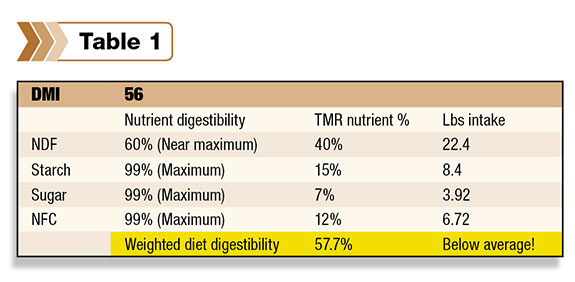Over the past couple of years, we’ve been able to measure what commercial dairy cattle digest on-farm by analyzing TMR and manure samples that nutritionists send us from high-cow pens. We measure TMR and manure nutrient content, a digestion marker, and then calculate what cows apparently digest (and conversely, what they did not). What we are measuring is in some cases eye-opening.
After looking at TMR nutrient composition, I tend to focus on TMR organic matter digestibility (OMD), which is somewhat similar to TDN, before honing in on nutrient (e.g. NDF) digestion. Organic matter is made up of proteins, fiber, starches, sugars and fats.
We find commercial dairy cattle are normally digesting somewhere between 48 and 83 percent of TMR organic matter and average around 65 percent, which agrees with what researchers measure in university experiments (Ferraretto et. al., 2013). With higher-performing rations we usually measure 65 to 75 percent OMD (Rock River Lab database, 2011 to 2013).
Much more than diet digestion is important for high production (e.g. management, genetics, cow comfort, transition program, etc.); however, collaborative work between our lab and a Midwest feed company’s nutritionists in 2010 and 2011 did find OMD was related to milk (Schalla et. al., 2012). The relationship makes sense and gives us a basis to use diet digestion as a tool to find profit opportunities.
Diet digestion can vary for many reasons, and the rumen is an extremely complex organ. We’re constantly learning and have been part of some interesting findings the past couple years. We’ll discuss some general TMR and digestion experiences we’ve seen that led to poor ration performance – and then discuss some fixes.
Our never-ending goal is to help your nutrition program gain ground, improve your feed conversion (here through improving digestion) and your bottom line. A word of caution though: work under the guidance of your nutritionist and support staff in diagnosing and working through situations like these.
Forage fiber digestibility
We can start out discussing the most common bottleneck that taxes performance: forages. We continue to have major opportunities here. Are you curious how forages are really performing? Then let’s look at TMR fiber digestion (where typically a majority of your TMR fiber is contributed by forages).
The average high-cow TMR fiber digestion is 38 percent. Yes, 38 percent, meaning high-producing cattle are only digesting 3.8 lbs of every 10 lbs of fiber they eat. With challenged forages, we have measured TMR NDFDs lower than 25 percent.
This is real and in spite of our forage reports showing 30-hour and 48-hour in-vitro (lab-bench rumen simulating) NDFDs in the 40 to 70 percent range.
With rations where fiber digestibility is a true bottleneck, we can sometimes work out of this situation by replacing forage fiber with more digestible fiber sources like corn gluten feed or soy hulls.
You could also consider reducing the amount of forage fiber in the diet as long as cud chewing and rumen health are still reasonable. Work with your nutritionist to consider other bottlenecks that might also be affecting fiber digestion.
Carbohydrate disconnect
Corn silage and other starchy ingredients can also get us into trouble. In 2013, many nutritionists are focusing on starch, and rightly so. We’re seeing ration total starch digestion averaging around 90 percent through cows, not taking into account how much ration starch was digested in the rumen.
We see some rations with starch digestion less than 85 percent, when top-performing diets are capable of nearly 100 percent starch digestion. Consider spreading 15 percent of your bushels back on the field when corn prices are bouncing between $5 and $8 per bu.
Nutritionists have been able to gain performance then by increasing the amount of grain, feeding pure starch or sugar or reducing grain particle size (Dr. B. Lammers, 2013 personal communication) – in some cases, gaining back 3 to 5 lbs of lost milk.
A side note: With an in-vivo digestion technique like we’re discussing here, we measure what cows digest through the entire digestive tract. Starch and sugar digestion is very important for the rumen and cow. While cows don’t have a starch requirement (Dr. L. Chase, 2013 personal communication), they do have a requirement for rapidly digestible carbohydrate.
With high-producing cows and higher DM intakes, feeds stay in the rumen for less time, and bacteria have less time to digest their meal, so optimizing readily available energy is important. Starch-digesting and sugar-digesting bacteria grow and provide fuel for protein, fiber and fat breakdown in the rumen.
When all the rumen bugs are working harmoniously, the rumen provides just as much protein (microbial) for milk production as your ration does, possibly allowing us to feed less-expensive protein. You can predict rumen starch digestion with lab-bench in-vitro rumen digestion techniques or use the UW Feed Grain Evaluation v2.0 (Hoffman et. al., 2012).
Fiber overload
We’ll round out our article with an interesting observation: We see some high-cow diets with low overall diet digestibility (OMD) despite above-average fiber and starch digestion. How can this be? There is an answer here related to fiber, but in this case it is due to amount.
Consider this: Real fiber digestibility averages 38 percent, like we discussed, and the highest TMR fiber digestibility we measure eclipses 60 percent, which is phenomenal. However, fiber digestion in dairy cattle almost never approaches starch and sugar digestion levels.

So we can have high fiber digestibility (60 percent for example) but too much fiber in the ration and not enough rapidly digestible starch or sugar (even if digestion averages max 99 percent).
The net result is our weighted-diet digestibility average (and diet OMD) is below average. See Table 1 .
So while we in the nutrition field tend to talk a great deal about NDFD (and in some cases measure unrealistically high NDFD values for forages), I want to clearly point out that the rumen needs and thrives on a minimum amount of digestible carbohydrates (fiber, starch and sugars).
Forage quality and NDFD matters (a lot), but even with some of the highest NDFD forages we can starve high-producing cows of rumen energy. Again, high-forage diets can work very well, but if we think our high-cow rumens are not firing on all cylinders, we can look at diet fiber and sugar/starch levels as well as nutrient digestibilities to make sure we have a balance in energy.
In wrapping up, I offer a final word of caution: Dairy nutrition is complex and the rumen is not easily understood; however, we can more quickly identify opportunities than we could several years ago and implement changes to improve performance. PD
Goeser earned a Ph.D. in animal nutrition from the University of Wisconsin – Madison and directs animal nutrition, research and innovation efforts at Rock River Lab Inc. based in Watertown, Wisconsin.
References omitted due to space but are available upon request. Click here to email an editor.

John Goeser
Director of Nutritional Research and Innovation
Rock River Laboratory






